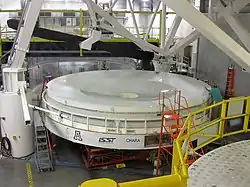Ohara Corporation
Ohara Inc. (株式会社オハラ, Kabushiki-gaisha Ohara) is a Japanese global glass manufacturing company. The company is headquartered in Sagamihara with subsidiaries in a number of countries, including Japan, the United States, Germany, Hong Kong, Malaysia, Taiwan, and China, with Ohara Corporation being the U.S. subsidiary of the Ohara Group. Ohara manufactures glasses since 1935, the year of its founding.
 | |
Native name | 株式会社オハラ |
|---|---|
| Type | Public (K.K) |
| TYO: 5218 | |
| ISIN | JP3197630001 |
| Industry | |
| Founded | October 1, 1935 |
| Founder | Jinpachi Ohara |
| Headquarters | Chuo-ku, Sagamihara, Kanagawa 252-5286 , Japan |
Area served | Worldwide |
Key people | Hirokazu Saito (President) |
| Products |
|
| Revenue | (US$ 255 million) |
(US$ 29.15 million) | |
Number of employees | 1,702 (consolidated, as of October 31, 2018) |
| Website | Official website |
| Footnotes / references [1][2][3] | |
Their web site lists areas of specialization, including:
- Optical Glass
- Polished Substates
- Fused Silica and Quartz
- IR Materials and Optical Crystals
- Low Expansion Glass
- Glass Ceramics
- Measurement Services
Optical glass

Among other things, Ohara is a major supplier of optical glass. Lens design programs will typically include glasses in the Ohara catalog among their stock material choices, along with, for example, glasses in the Schott catalog.[4] On their website, Ohara describes a line of more than 130 environmentally safe glasses, produced without lead and arsenic.
They produce more than 300 tons of optical glass a month (against 10800 tons/month for Schott and over 108000 tons/month for Corning). The glass is available in a variety of forms, including strip, slab, cut blanks, and pressings.
Ohara includes in its catalog the famous E6 borosilicate (similar to Corning's Pyrex), ClearCeram-Z (a vitroceramic similar to Schott's Zerodur), and two well-known low dispersion glasses: FPL51 (the UD glass used by Canon) and FPL53 showing properties close to fluorite.
Telescope mirror glass
Ohara supplied over 23.5 tons of their E6 borosilicate glass, the purest optical glass in the world,[5] to be cast into the blank of the primary and tertiary mirror of the Large Synoptic Survey Telescope.[6]
E6 glass was also used to manufacture the mirror of the Giant Magellan Telescope[7] and the Large Binocular Telescope,[8] both having a primary mirror 8.4 m wide.
References
- "Corporate Data". Ohara Inc. Retrieved May 6, 2019.
- "About the company". Financial Times. Retrieved May 6, 2019.
- "Company Profile". Nikkei Asian Review. Nikkei Inc. Retrieved May 6, 2019.
- For instance the OSLO program includes Schott, Ohara, Hoya, Corning, and Sumita glass catalogs, see Sinclair Optics web site under Software|Technical Data|Catalogs/Libraries
- Bennett, Jay (February 14, 2018). "The Deep Space Eye in the Desert". Popular Mechanics. Retrieved May 6, 2019.
- Stiles, Lori (March 17, 2008). "UA Mirror Lab to Cast Two Mirrors in One for the LSST". University of Arizona. Retrieved July 25, 2009.
- Tarantola, Andrew (March 9, 2014). "How the Enormous Mirrors on the World's Largest Telescope Are Made". Gizmodo. Retrieved May 6, 2019.
- Stepp, Larry M.; Hill, John M.; Angel, James Roger P.; Lutz, Randall D.; Olbert, Blain H.; Strittmatter, Peter A. (1998). "Casting the first 8.4-m borosilicate honeycomb mirror for the Large Binocular Telescope". 3352: 172–181. doi:10.1117/12.319295. ISSN 0277-786X. Cite journal requires
|journal=(help)
External links
- Ohara Group (in English)